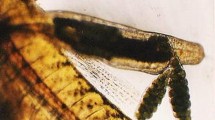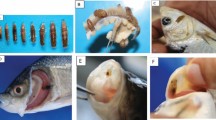Abstract
Lesions ranging from surface wounds to deep tissue wounds caused by cormorant predation were observed on several species of the farmed fish in Pohořelice, Czech Republic. Two-year-old stocked common carp Cyprinus carpio harvested in late March were examined for ectoparasites and endoparasites, injuries extent, and lysozyme concentration in skin mucus. Additionally, three body condition indices were measured. Endoparasite infection occurred only scarcely. Wounded fish were more susceptible to the ectoparasites Gyrodactylus spp. and Dactylogyrus spp. (Monogenea), and Ichthyophthirius multifiliis (Ciliophora). The intensity of infection of other ectoparasites Eudiplozoon nipponicum (Monogenea), Argulus spp. (Branchiura) and trichodinids (Ciliophora) did not significantly differ between wounded and control groups of fish. Lysozyme concentration in fish mucus was significantly higher in wounded fish and was positively associated with both the extent of damaged epithelium and Gyrodactylus spp. abundance. There were no differences in Fulton’s condition factor and lipid content in muscle and liver tissues between wounded and non-wounded fish. Higher values of spleen-somatic index in wounded fish corresponded to increased intensity of parasite infection, most likely reflecting changes in immune system of infected fish. Although our results did not show any significant effect of cormorant attacks on fish condition, the wounded fish had significantly higher parasite numbers which could impact the growth or survival of the fish throughout the production season.


Similar content being viewed by others
References
Adámek Z, Kortan J, Flajšhans M (2007) Computer assisted image analysis in evaluation of fish wounding by cormorant (Phalacrocorax carbo sinensis (L.)) attacks. Aquacult Int 15:211–216
Alvarez-Pellitero P (2008) Fish immunity and parasite infection: from innate immunity to immunoprophylactic prospects. Vet Immunol Immunopathol 126:171–168
Andersen PS, Buchmann K (1998) Temperature dependent population growth of Gyrodactylus derjavini on rainbow trout, Oncorhynchus mykiss. J Helm 72:9–14
Bakke TA, Harris PD, Jansen PA, Hansen LP (1992) Host specificity and dispersal strategy in gyrodactylid monogeneans, with particular reference to Gyrodactylus salaris (Platyhelminthes, Monogenea). Dis Aquat Org 13:63–74
Blažek R, Bagge A, Valtonen ET (2008) Monogenean assemblages and the apparent transmission capability of monogeneans between related fish species: an experimental study. Parasitol Res 102:1359–1366
Buchmann K, Bresciani J (1997) Parasitic infections in pond-reared rainbow trout Oncorhynchus mykiss in Denmark. Dis Aquat Org 28:125–138
Buchmann K, Lindenstrøm T (2002) Interactions between monogenean parasites and their hosts. Int J Parasitol 32:309–319
Bush AO, Lafferty KD, Lotz JM, Shostak AW (1997) Parasitology meets ecology on its own terms: Margolis et al. revised. J Parasitol 83:575–583
Caipang CMA, Berg I, Brinchmann MF, Kiron V (2009) Short-term crowding stress in Atlantic cod. Gadus morhua L. modulates the humoral immune response. Aquaculture 295:110–115
Carss DN (1990) Beak prints help in war against aerial invaders. Fish Farmer 13:46–47
Davies JM, Feltham MJ, Walsingham MV (1995) Fish wounding by cormorants, Phalacrocorax carbo L. Fish Manag Ecol 2:321–324
Davis KB, Griffin BR, Gray WL (2002) Effect of handling stress on susceptibility to channel catfish Ictalurus punctatus to Ichthyophthirius multifiliis and channel catfish virus infection. Aquaculture 214:55–66
Ergens R, Lom J (1970) Causative agents of parasitic fish diseases. Academia, Prague
Ewing MS, Ewing SA, Zimmer MA (1982) Sub lethal copper stress and susceptibility of channel catfish Ictalurus punctatus to experimental infections with Ichthyophthirius multifiliis. Bull Environ Contam Toxicol 28:674–68
Grémillet D, Enstipp MR, Boudiffa M, Liu H (2006) Do cormorants injure fish without eating them? An underwater video study. Mar Biol 148:1081–1087
Harris PD, Soleng A, Bakke TA (2000) Increased susceptibility of salmonids to the monogenean Gyrodactylus salaris following administration of hydrocortisone acetate. Parasitology 120:57–64
Kortan J, Adámek Z (2011) Behavioural response of carp (Cyprinus carpio, L.) pond stock upon occurrence of hunting great cormorant (Phalacrocorax carbo sinensis) flocks. Aquacult Int 19:121–129
Kortan J, Adámek Z, Flajšhans M, Piačková V (2008) Indirect manifestation of cormorant (Phalacrocorax carbo (L.)) predation of pond fish stock. Knowl Managt Aquatic Ecosyst 389:01
Kortan J, Bláhová J, Kružíková K, Adámek Z (2011) Stress responses of carp pond fish stock upon hunting activities of great cormorant (Phalacrocorax carbo sinensis (L.)). Aquacult Res 42:322–330
Marsh-Matthews E, Brooks M, Deaton R, Tan H (2005) Effects of maternal and embryo characteristics on post-fertilization provisioning in fishes of the genus Gambusia. Oecologia 144:12–24
Matthews RA (2005) Ichthyophthirius multifiliis fouquet and ichthyophthiriosis in freshwater teleosts. Adv Parasitol 59:159–241
Moerbeek DJ, Van Dobben WH, Osieck ER, Boere GC, Bundenberg de Jong CM (1987) Cormorant damage prevention at fish farm in the Netherlands. Biol Conserv 39:23–38
Montero D, Izquierdo MS, Tort L, Robaine L, Vergara JM (1999) High stocking density produces crowding stress altering some physiological and biochemical parameters in gilthead seabream, Sparus aurata, juveniles. Fish Physiol Biochem 20:53–60
Oppliger A, Clobert J, Lecomte J, Lorenzon P, Boudjemadi K, John-Alder HB (1998) Environmental stress increases the prevalence and intensity of blood parasite infection in the common lizard Lacerta vivipara. Ecol Letters 1:129–138
Overstreet RM, Cukran SS (2004) Defeating diplostomoid dangers in USA catfish aquaculture. Folia Parasitol 51:153–165
Palíková M, Svobodová Z (1995) Biological indicators of stress in fish (review). Bull VÚRH JU Vodňany 31:17–27
Poisot T, Šimková A, Hyršl P, Morand S (2009) Interaction between immunocompetence, somatic condition and parasitism in the chub Leuciscus cephalus in early spring. J Fish Biol 75:1667–1682
Poór C (2005) The influence of cormorant (Phalacrocorax carbo Linné, 1758) on fish population in open waters in Hungary. In: Topical problems in water ecosystems protection, Abstract Book. Průhonice, Czech Republic
Saurabh S, Sahoo PK (2008) Lysozyme: an important defence molecule of fish innate immune system. Aquacult Res 39:223–239
Seppänen E, Kuukka H, Voutilainen A, Huuskonen H, Peuhkuri N (2009) Metabolic depression and spleen and liver enlargement in juvenile Arctic charr Salvelinus alpinus exposed to chronic parasite infection. J Fish Biol 74:553–561
Skarstein F, Folstad I, Liljedal S (2001) Whether to reproduce or not: immune suppression and costs of parasites during reproduction in the Arctic charr. Can J Zool 79:271–78
Acknowledgement
The study was supported by the Ichthyoparasitology, Centre of Excellence (LC 522) of the Ministry of Education of the Czech Republic (MO, ZV, LV) and USB RIFCH projects no. CENAKVA CZ.1.05/2.1.00/01.0024 and GA JU 047/2010/Z (JK, ZA). We would like to thank Rybníkářství (“Pond Fisheries”) Pohořelice Co. for their support and co-operation and Iveta Matejusova-Douglas for English correction and critical comments.
Author information
Authors and Affiliations
Corresponding author
Rights and permissions
About this article
Cite this article
Ondračková, M., Valová, Z., Kortan, J. et al. Consequent effects of the great cormorant (Phalacrocorax carbo sinensis) predation on parasite infection and body condition of common carp (Cyprinus carpio). Parasitol Res 110, 1487–1493 (2012). https://doi.org/10.1007/s00436-011-2652-5
Received:
Accepted:
Published:
Issue Date:
DOI: https://doi.org/10.1007/s00436-011-2652-5




